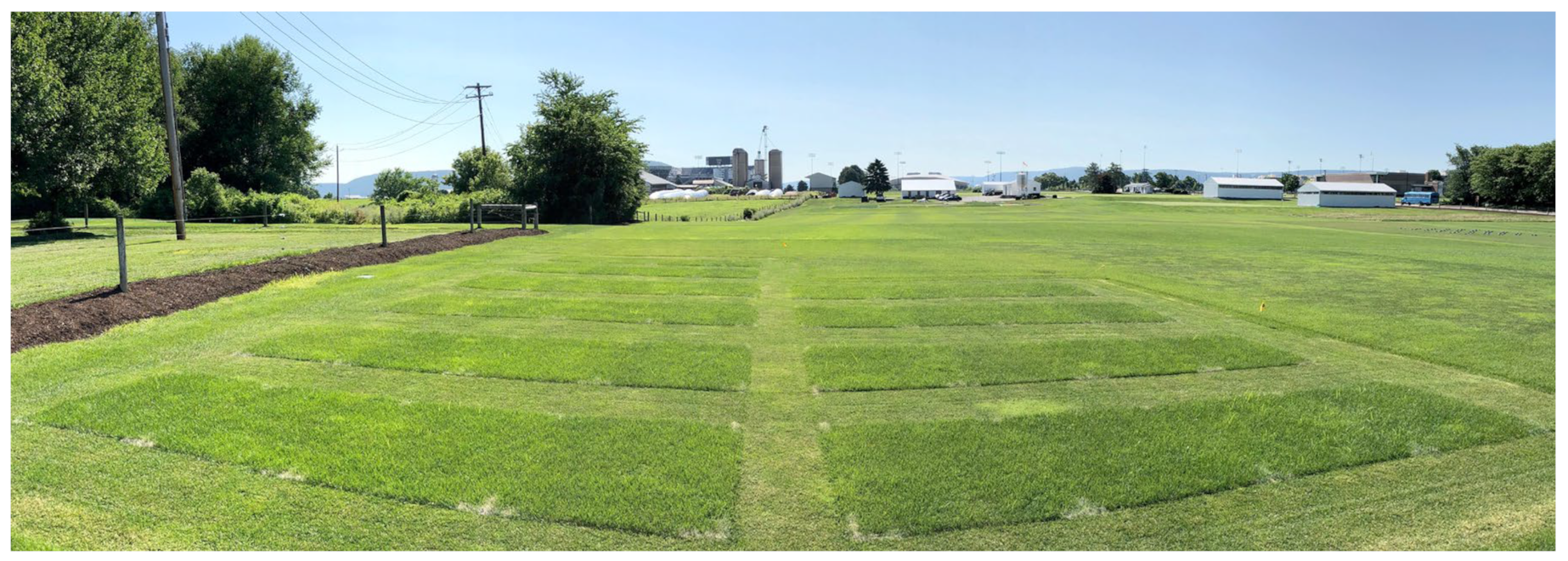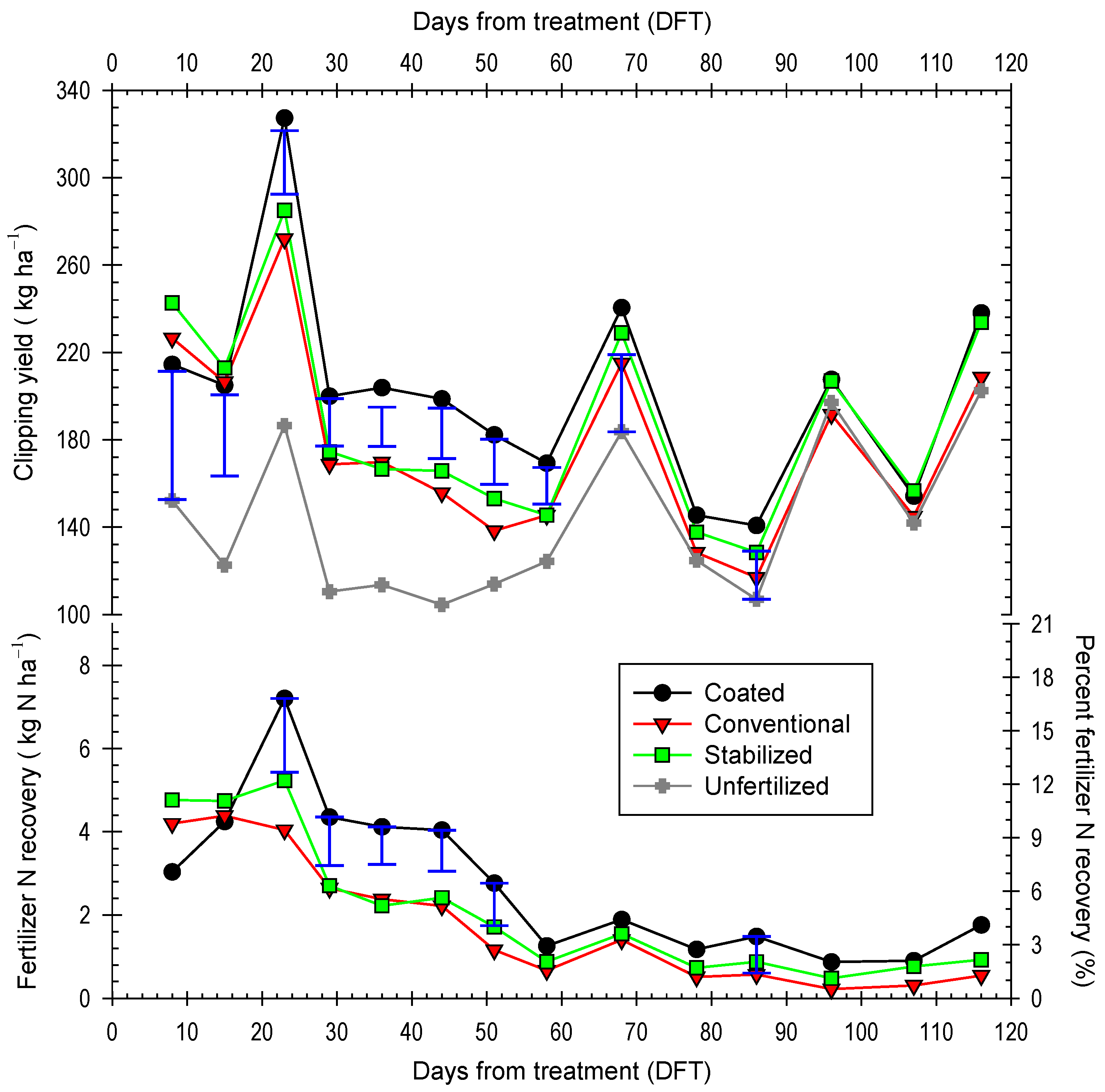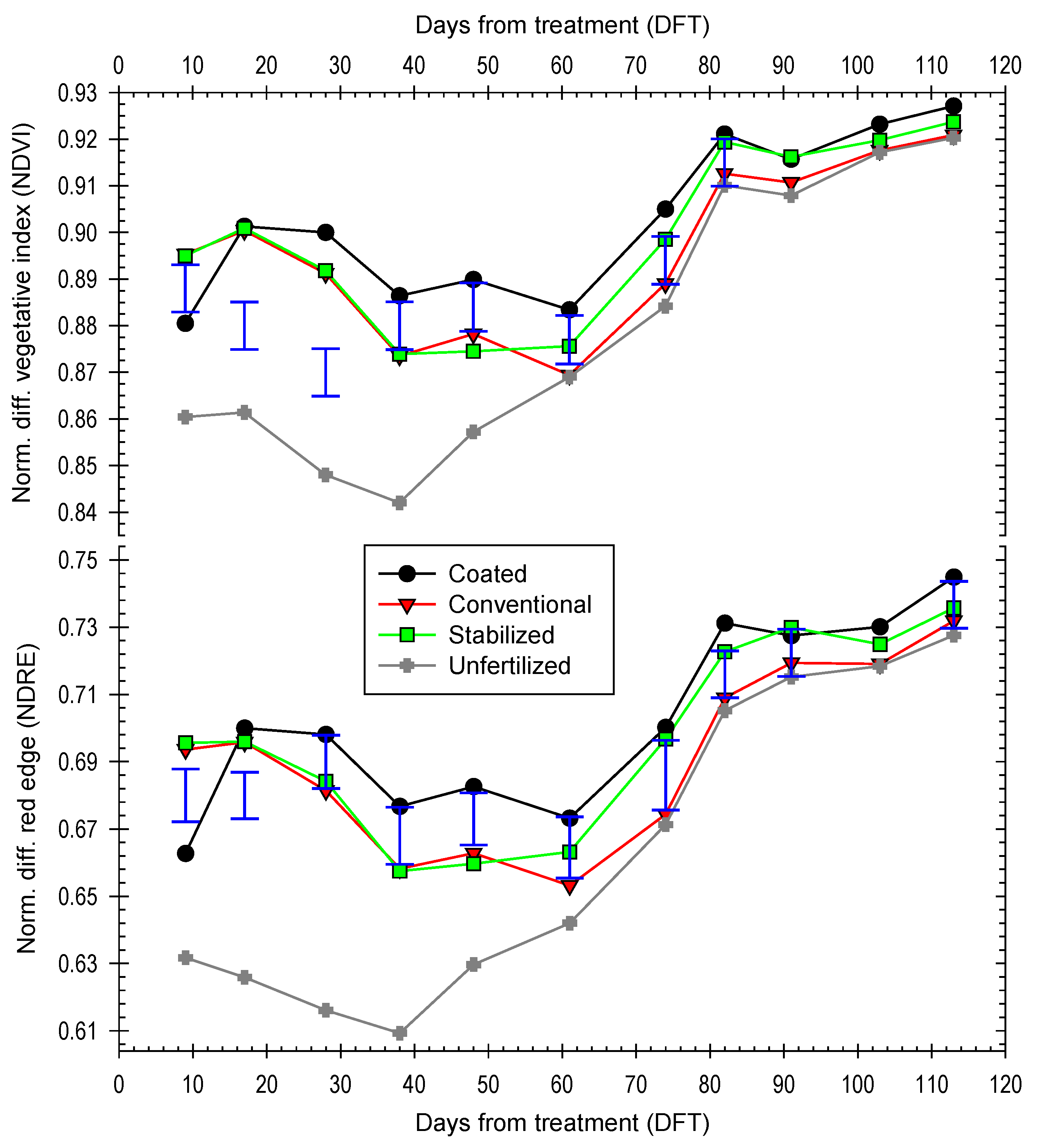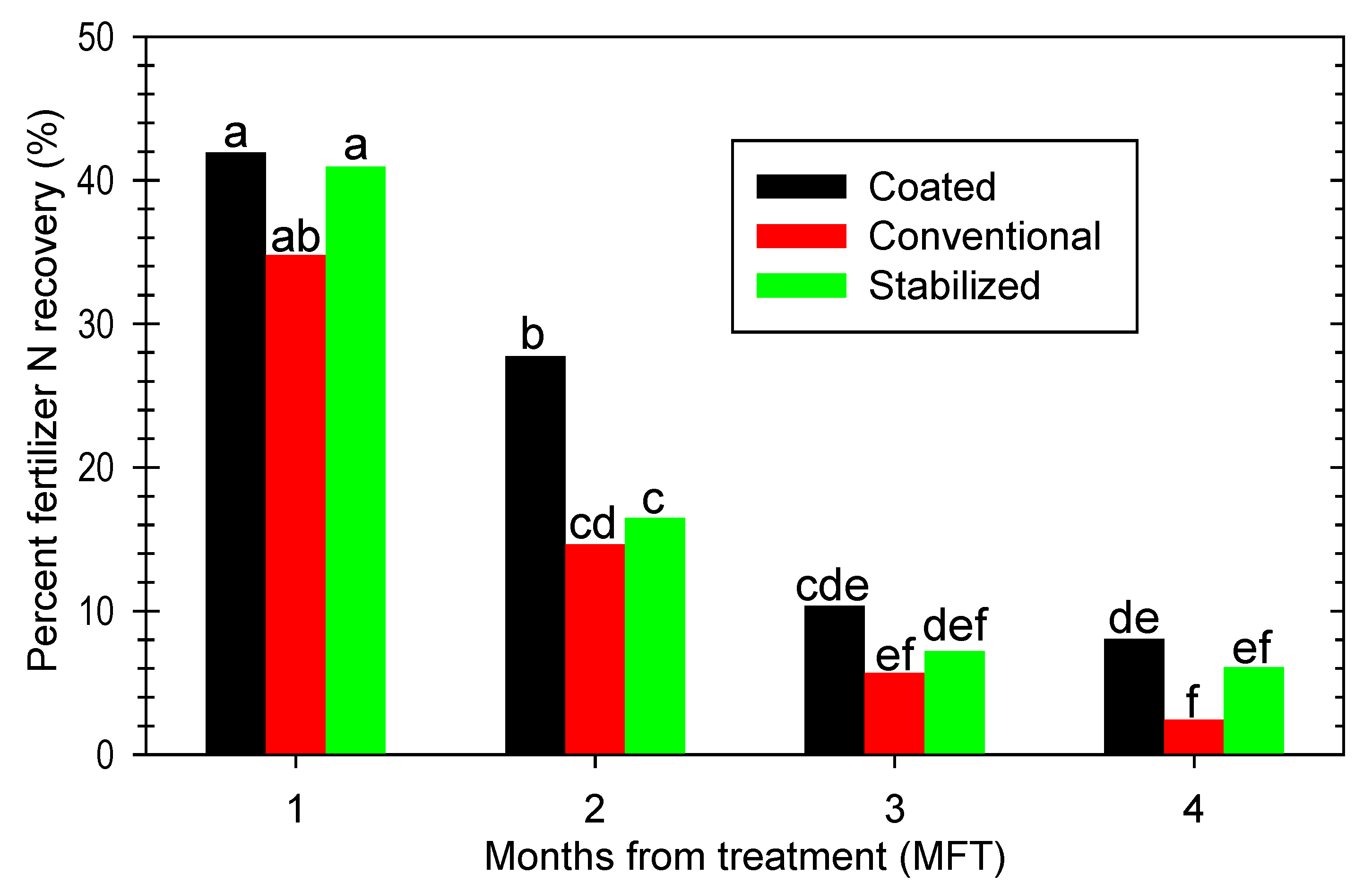Field Evaluation of Urea Fertilizers Enhanced by Biological Inhibitors or Dual Coating
Abstract
1. Introduction
2. Materials and Methods
3. Results
3.1. Clipping Yield
3.2. Fertilizer Nitrogen Recovery
3.3. Canopy Characteristics
3.4. Monthly Percent Fertilizer N Recovery
4. Discussion
5. Conclusions
Author Contributions
Funding
Data Availability Statement
Conflicts of Interest
References
- Taylor, N.; Howell, K.; Heazlewood, J.; Tan, T.; Narsai, R.; Huang, S.; Whelan, J.; Millar, A. Analysis of the rice mitochondrial carrier family reveals anaerobic accumulation of a basic amino acid carrier involved in arginine metabolism during seed germination. Plant Physiol. 2010, 154, 691–704. [Google Scholar] [CrossRef] [PubMed]
- Merigout, P.; Lelandais, M.; Bitton, F.; Renou, J.-P.; Briand, X.; Meyer, C.; Daniel-Vedele, F. Physiological and transcriptomic aspects of urea uptake and assimilation in Arabidopsis plants. Plant Physiol. 2008, 147, 1225. [Google Scholar] [CrossRef] [PubMed]
- Eckert, M.; Biela, A.; Siefritz, F.; Kaldenhoff, R. New aspects of plant aquaporin regulation and specificity. J. Exp. Bot. 1999, 50, 1541–1545. [Google Scholar]
- Liu, L.H.; Ludewig, U.; Gassert, B.; Frommer, W.B.; von Wiren, N. Urea transport by nitrogen-regulated tonoplast intrinsic proteins in Arabidopsis. Plant Physiol. 2003, 133, 1220. [Google Scholar]
- Kojima, S.; Bohner, A.; von Wiren, N. Molecular mechanisms of urea transport in plants. J. Membr. Biol. 2006, 212, 83–91. [Google Scholar]
- Merigout, P.; Gaudon, V.; Quillere, I.; Briand, X.; Daniel-Vedele, F. Urea use efficiency of hydroponically grown maize and wheat. J. Plant Nutr. 2008, 31, 427. [Google Scholar] [CrossRef]
- Bowman, D.C.; Paul, J.L. Foliar absorption of urea, ammonium, and nitrate by perennial ryegrass turf. J. Am. Soc. Hortic. Sci. 1992, 117, 75–79. [Google Scholar]
- Chin, W.; Kroontje, W. Urea hydrolysis and subsequent loss of ammonia. Soil Sci. Soc. Am. J. 1963, 27, 316–318. [Google Scholar] [CrossRef]
- Torello, W.A.; Wehner, D.J. Urease activity in a Kentucky bluegrass turf. Agron. J. 1983, 75, 654–656. [Google Scholar]
- Petrovic, A.M. The fate of nitrogenous fertilizers applied to turfgrass. J. Environ. Qual. 1990, 19, 1–14. [Google Scholar]
- Bernardi, A.C.C.; Mota, E.P.; Cardosa, R.D.; Monte, M.B.M.; Oliveira, P.P.A. Ammonia volatilization from soil, dry-matter yield, and nitrogen levels of Italian ryegrass. Comm. Soil Sci. Plant Anal. 2014, 45, 153–162. [Google Scholar] [CrossRef]
- Rochette, P.; Angers, D.A.; Chantigny, M.H.; MacDonald, J.D.; Gasser, M.-O.; Bertrand, N. Reducing ammonia volatilization in a no-till soil by incorporating urea and pig slurry in shallow bands. Nutr. Cycl. Agroecosyst. 2009, 84, 71–80. [Google Scholar] [CrossRef]
- Titko, S., III; Street, J.R.; Logan, T.J. Volatilization of ammonia from granular and dissolved urea applied to turfgrass. Agron. J. 1987, 79, 535–540. [Google Scholar]
- Bowman, D.C.; Paul, J.L.; Davis, W.B.; Nelson, S.H. Reducing ammonia volatilization from Kentucky bluegrass turf by irrigation. HortScience 1987, 22, 84–87. [Google Scholar]
- Holcomb, J.C.; Sullivan, D.M.; Horneck, D.A.; Clough, G.H. Effect of irrigation rate on ammonia volatilization. Soil Sci. Soc. Am. J. 2011, 75, 2341–2347. [Google Scholar]
- Carrow, R.N.; Waddington, D.V.; Rieke, P.E. Turfgrass Soil Fertility and Chemical Problems: Assessment and Management; John Wiley & Sons: Hoboken, NJ, USA, 2001; pp. 306–318. ISBN 1-57504-153-7. [Google Scholar]
- Kiss, S.; Simihaian, M. Improving Efficiency of Urea Fertilizers by Inhibition of Soil Urease Activity; Kluwer Academic Publishers: Norwell, MA, USA, 2002; pp. 142–419. ISBN 1-4020-0493-1. [Google Scholar]
- McCarty, G.W.; Bremner, J.M.; Chai, H.S. Effect of N-(n-butyl) thiophosphoric triamide on hydrolysis of urea by plant, microbial, and soil urease. Biol. Fertil. Soils 1989, 8, 123–127. [Google Scholar] [CrossRef]
- Manunza, B.; Deiana, S.; Pintire, M.; Gessa, C. The binding mechanism of urea, hydroxamic acid and N-(N-butyl)-phosphoric triamide to the urease active site: A comparative molecular dynamics study. Soil Biol. Biochem. 1999, 31, 789–796. [Google Scholar] [CrossRef]
- Silva, A.G.B.; Sequeira, C.H.; Sermarini, R.A.; Otto, R. Urease inhibitor NBPT on ammonia volatilization and crop productivity: A meta-analysis. Agron. J. 2017, 109, 1–13. [Google Scholar]
- Del Moro, S.K.; Sullivan, D.M.; Horneck, D.A. Ammonia volatilization from broadcast urea and alternative dry nitrogen fertilizers. Soil Sci. Soc. Am. J. 2018, 81, 1629–1639. [Google Scholar]
- Engel, R.; Jones, C.; Romero, C.; Wallander, R. Late-fall, winter and spring broadcast applications of urea to no-till winter wheat I. Ammonia loss and mitigation by NBPT. Soil Sci. Soc. Am. J. 2017, 81, 322–330. [Google Scholar] [CrossRef]
- Sunderlage, B.; Cook, R.L. Soil property and fertilizer additive effects on ammonia volatilization from urea. Soil Sci. Soc. Am. J. 2018, 82, 253–259. [Google Scholar] [CrossRef]
- Skogley, C.R.; King, J.W. Controlled release nitrogen fertilization of turfgrass. Agron. J. 1968, 60, 61–64. [Google Scholar]
- Boulin, G.M.; Rindt, D.W.; Moore, O.E. Sulfur-coated fertilizers for controlled release. Pilot-plant production. J. Agric. Food Chem. 1971, 19, 801–808. [Google Scholar]
- Rindt, D.W.; Blouin, G.M.; Getsinger, J.G. Sulfur coating on nitrogen fertilizer to reduce dissolution rate. J. Agric. Food Chem. 1968, 16, 773–778. [Google Scholar]
- Allen, S.E.; Hunt, C.M.; Terman, G.L. Nitrogen release from sulfur coated urea as affected by coating weight placement and temperature. Agron. J. 1971, 63, 529. [Google Scholar]
- Zhang, M.; Nyborg, N.; Malhi, S.S. Comparison of controlled release nitrogen fertilizers on turfgrass in a moderate temperature area. HortScience 1998, 33, 1203–1206. [Google Scholar]
- Carrow, R.N. Turfgrass response to slow-release nitrogen fertilizers. Agron. J. 1997, 89, 491–496. [Google Scholar]
- Guillard, K.; Kopp, K.L. Nitrogen fertilizer form and associated nitrate leaching from cool-season lawn turf. J. Environ. Qual. 2004, 33, 1822–1827. [Google Scholar] [CrossRef]
- Snyder, G.H.; Augustin, B.J.; Davison, J.M. Moisture sensor-controlled irrigation for reducing N leaching in bermudagrass turf. Agron. J. 1984, 76, 964. [Google Scholar]
- Knight, E.C.; Guertal, E.A.; Wood, C.W. Mowing and nitrogen source effects on ammonia volatilization from turfgrass. Crop. Sci. 2007, 47, 1628–1634. [Google Scholar]
- Schlossberg, M.J.; McGraw, B.A.; Sebring, R.L.; Hivner, K.R. Nitrogen recovery and loss from Kentucky bluegrass fertilized by conventional or enhanced-efficiency urea granules. Agronomy 2018, 8, 144. [Google Scholar] [CrossRef]
- Braun, R.C.; Bremer, D.J. Nitrous oxide emissions from turfgrass receiving different irrigation amounts and nitrogen fertilizer forms. Crop. Sci. 2018, 58, 1762. [Google Scholar] [CrossRef]
- Gillette, K.L.; Qian, Y.; Follett, R.F.; Del Grosso, S. Nitrous oxide emissions from a golf course fairway and rough after application of different nitrogen fertilizers. J. Environ. Qual. 2016, 45, 1788–1795. [Google Scholar] [CrossRef]
- Maggiotto, S.R.; Webb, J.A.; Wagner-Riddle, C.; Thurtell, G.W. Nitrous and nitrogen oxide emissions from turfgrass receiving different forms of nitrogen fertilizer. J. Environ. Qual. 2000, 29, 621–630. [Google Scholar]
- LeMonte, J.J.; Jolley, V.D.; Summerhays, J.S.; Terry, R.E.; Hopkins, B.G. Polymer coated urea in turfgrass maintains vigor and mitigates nitrogen’s environmental impacts. PLoS ONE 2016, 11, e0146761. [Google Scholar] [CrossRef]
- Schlossberg, M.J. Temporal recovery of polymer-coated urea-N by Kentucky bluegrass in the field. Horticulturae 2022, 8, 207. [Google Scholar] [CrossRef]
- Henning, S.W.; Branham, B.E.; Mulvaney, R.L. Response of turfgrass to urea-based fertilizers formulated to reduce ammonia volatilization and nitrate conversion. Biol. Fertil. Soils 2013, 49, 51–60. [Google Scholar]
- Zhu, Q.; Schlossberg, M.J.; Bryant, R.B. Foliar fertilization–induced injury and recovery of a creeping bentgrass putting green. J. Plant Nutr. 2016, 39, 1589–1596. [Google Scholar] [CrossRef]
- Karcher, D.E.; Richardson, M.D. Quantifying turfgrass color using digital image analysis. Crop. Sci. 2003, 43, 943–951. [Google Scholar]
- Baret, F.; Guyot, G. Potentials and limits of vegetation indices for LAI and APAR assessment. Remote Sens. Environ. 1991, 35, 161–173. [Google Scholar]
- Barnes, E.M.; Clarke, T.R.; Colaizzi, P.; Haberland, J.; Kostrzewski, M.; Riley, E.; Moran, S.; Waller, P.; Choi, C. Coincident detection of crop water stress, nitrogen status, and canopy density using ground-based multispectral data. In Proceedings of the 5th International Conference on Precision Agriculture, Bloomington, MN, USA, 16–19 July 2000; Precision Agriculture Center, University of Minnesota: Madison, WI, USA, 2000. [Google Scholar]
- Leiby, N.L.; Schlossberg, M.J. Putting green canopy reflectance by time from colourant and spray oil combination product application. Int. J. Remote Sens. 2022, 43, 7024. [Google Scholar] [CrossRef]
- McIntosh, M.S. Analysis of combined experiments. Agron. J. 1983, 75, 153–155. [Google Scholar] [CrossRef]
- DeKlerk, N.H. Repeated warnings re repeated measures. Aust. N. Z. J. Med. 1986, 16, 637–638. [Google Scholar] [CrossRef]
- Matthews, J.N.S.; Altman, D.G.; Campbell, M.J.; Royston, P. Analysis of serial measurements in medical research. Br. Med. J. 1990, 300, 230–235. [Google Scholar]
- Piepho, H.P.; Eckl, T. Analysis of series of variety trials with perennial crops. Grass Forage Sci. 2014, 69, 431–440. [Google Scholar] [CrossRef]
- Marschner, P. Mineral Nutrition of Higher Plants, 3rd ed.; Elsevier: San Diego, CA, USA, 2012. [Google Scholar]
- Lindsey, A.J.; Thoms, A.W.; McDaniel, M.D.; Christians, N.E. Plant-available soil nitrogen fluxes and turfgrass quality of Kentucky bluegrass fertilized with humic substances. Crop Sci. 2021, 61, 4416–4424. [Google Scholar] [CrossRef]






| 2014 | 2018 | |||
|---|---|---|---|---|
| Mean Air | Total | Mean Air | Total | |
| Month(s) | Temperature (°C) | Precipitation (cm) | Temperature (°C) | Precipitation (cm) |
| January to April | 0.1 | 21.2 | 1.9 | 37.4 |
| May | 16.9 | 14.3 | 19.1 | 14.8 |
| June | 21.6 | 14.1 | 20.4 | 9.7 |
| July | 22.7 | 21.5 | 22.8 | 14.6 |
| August | 20.5 | 18.7 | 23.1 | 12.3 |
| September | 18.1 | 4.1 | 20.0 | 15.9 |
| df | Clipping | df | Canopy | df | Fertilizer N | ||||||
|---|---|---|---|---|---|---|---|---|---|---|---|
| Source | Num | Den | Yield | Num | Den | DGCI | NDRE | NDVI | Num | Den | Recovery |
| p value | p value | p value | |||||||||
| Fertilizer (FERT) | 3 | 3 | 0.019 | 3 | 3 | 0.023 | 0.014 | 0.017 | 2 | 2 | 1 ns |
| Days from treatment (DFT) | 13 | 13 | ns | 10 | 10 | 0.037 | 0.024 | 0.043 | 13 | 13 | <0.001 |
| FERT × DFT | 39 | 39 | <0.001 | 30 | 30 | <0.001 | <0.001 | <0.001 | 26 | 26 | 0.041 |
| Fertilizer | Mean, kg ha−1 | Mean, unitless | Mean, kg ha−1 | ||||||||
| Coated urea (XCU) | 202 | 0.692 | 0.703 | 0.903 | 2.79 | ||||||
| Conventional urea | 178 | 0.683 | 0.691 | 0.896 | 1.80 | ||||||
| Stabilized urea (UMAXX) | 188 | 0.689 | 0.697 | 0.899 | 2.14 | ||||||
| Unfertilized control | 142 | 0.668 | 0.663 | 0.880 | – | ||||||
| 2 LSD 5% | 26.6 | 0.012 | 0.016 | 0.010 | ns | ||||||
Disclaimer/Publisher’s Note: The statements, opinions and data contained in all publications are solely those of the individual author(s) and contributor(s) and not of MDPI and/or the editor(s). MDPI and/or the editor(s) disclaim responsibility for any injury to people or property resulting from any ideas, methods, instructions or products referred to in the content. |
© 2024 by the authors. Licensee MDPI, Basel, Switzerland. This article is an open access article distributed under the terms and conditions of the Creative Commons Attribution (CC BY) license (https://creativecommons.org/licenses/by/4.0/).
Share and Cite
Brace, B.E.; Schlossberg, M.J. Field Evaluation of Urea Fertilizers Enhanced by Biological Inhibitors or Dual Coating. Agronomy 2024, 14, 2118. https://doi.org/10.3390/agronomy14092118
Brace BE, Schlossberg MJ. Field Evaluation of Urea Fertilizers Enhanced by Biological Inhibitors or Dual Coating. Agronomy. 2024; 14(9):2118. https://doi.org/10.3390/agronomy14092118
Chicago/Turabian StyleBrace, Ben E., and Maxim J. Schlossberg. 2024. "Field Evaluation of Urea Fertilizers Enhanced by Biological Inhibitors or Dual Coating" Agronomy 14, no. 9: 2118. https://doi.org/10.3390/agronomy14092118
APA StyleBrace, B. E., & Schlossberg, M. J. (2024). Field Evaluation of Urea Fertilizers Enhanced by Biological Inhibitors or Dual Coating. Agronomy, 14(9), 2118. https://doi.org/10.3390/agronomy14092118







